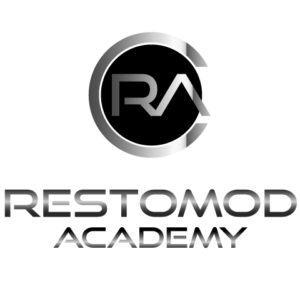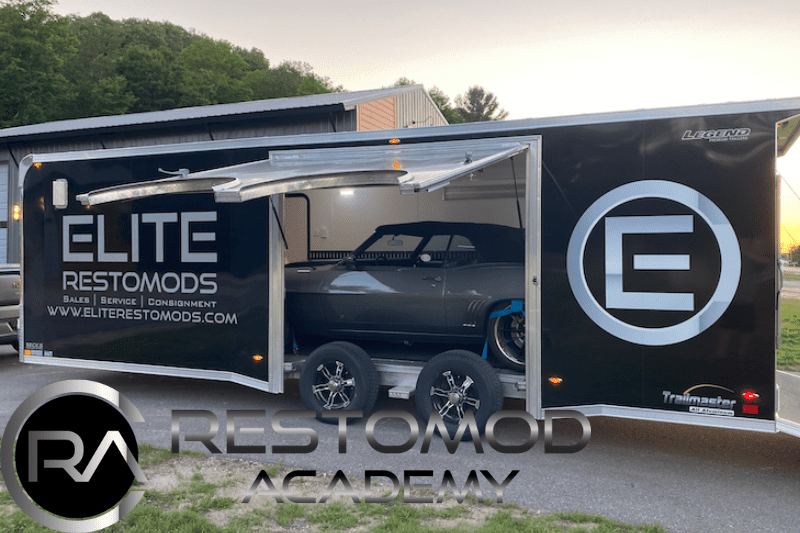Whether you are looking for an enclosed trailer with a 7,000 Gross Vehicle Weight Rating (GVWR) or an air ride equipped suspension, this complete guide to restomod enclosed trailers can help. Reports can lead you through the enclosed trailer buying experience. However, we provide the essential information you need to choose, buy, finance, and maintain your restomod enclosed trailer. Please enjoy the Complete Guide to Buying An Enclosed Trailer for Your Restomod.
State laws factor into this decision, quite possibly, more than you know. BEFORE BUYING AN ENCLOSED TRAILER FOR A RESTOMOD CHECK YOUR STATE LAWS USING THIS LINK TO THE DIGEST OF MOTOR LAWS ON THE AAA WEBSITE:
Complete Guide to Buying An Enclosed Trailer for Your Restomod – New Or Used Restomod Enclosed Trailer
New trailers
There is tremendous competition among trailer manufacturers which means buying new trailers isn’t nearly as expensive as many people think. However, what the uninformed buyer doesn’t know is the new trailer is not a profitable product quite yet. In other words, the dealer probably has zero to actually a negative margin in the trailer. And, because there are a plethora of upgrades available, you’ll be asked to buy darn near all of them.
The Pros of buying a new enclosed trailer are as follows:
- Warranty. There will be some type of limited warranty and that can be a very nice thing to have. Make sure to fill out the registration to make certain the warranty is in effect.
- History. Because you are buying a brand new trailer, you know its history. In other words, there is nothing in the history of the trailer that a seller didn’t inform you about. So, you’re buying something that is truly in mint condition. There are very few surprises about buying a new trailer in other words.
- Customization. The chance to design the enclosed trailer exactly the way you want it is a great benefit. You can really narrow it down to your specific requirements and maximize how the money is allocated.
The Cons of buying a new enclosed trailer is as follows:
- Sales Process. As I said before, dealing with salespeople and going through the entire process of options can be overwhelming.
- Bait and Switch. While I wouldn’t categorize the process as a bait and switch, many buyers think the process is exactly that. The buyer is brought into a dealership at a low price. Then, upon leaving the dealership they are left wondering how the price increased 25-40%.
Complete Guide to Buying An Enclosed Trailer for Your Restomod – Used trailers

As expected, the biggest advantage of buying a used enclosed trailer for your restomod is the price. And, because of the initial cost of a new trailer, they take a sizable depreciation hit. This is similar to what happens when buying a new car.
Many buyers purchase an enclosed trailer, without reading a guide like this, and quickly learn it’s just heavier than they expected. In some cases, a bit less common but real nonetheless, their vehicle cannot properly tow the trailer. In other situations, the spouse simply doesn’t like the eyesore in the driveway. And, a lot of homeowner associations (HOAs) have rules against enclosed trailers in the driveway.
The Pros of buying a used enclosed trailer are as follows:
- Buying Power. You can usually get a load-used enclosed trailer for far less than a bare-bones new one.
- Availability. There are a ton of used enclosed trailers so it’s really a buyer’s market.
The Cons of buying a used enclosed trailer is as follows:
- History. Not knowing the history of an enclosed trailer is a major disadvantage of buying a used enclosed trailer. Without knowing how the trailer has been treated, you are potentially putting your restomod at risk.
- Warranty. I am not 100% sure how much of a negative not having a warranty really is. Warranties vary quite a bit by the manufacturer from 90 days full warranty on the low side to three years (limited warranty) on the high side. Reading and comprehending some of these warranties is quite an undertaking that, in and of itself, seems to undermine their effectiveness.
New vs used enclosed trailer takeaways
Regardless of whether you buy a new or used enclosed trailer for your restomod, this guide will help you nail down your requirements. Those requirements can then be leveraged to make sure you pay for you what you. And, most importantly, make sure you avoid paying for what you don’t.
I have purchased trailers used and new. I have been happy with both scenarios. There are pros and cons just like we have already covered. I will say this, if you are new to restomodding, be patient as there is a very strong community amongst restomod and general classic car enthusiasts. As your network grows, you’ll have access to a number of great used enclosed, and open trailer deals for that matter, that are quite powerful.
Complete Guide to Buying An Enclosed Trailer for Your Restomod – Trailer Length
When purchasing the enclosed trailer for your restomod, obviously length is one of the first considerations. If you’ve done any shopping online this can be an overwhelming process. Enclosed trailers come in a tremendous variety of lengths, weights, and designs. Not to mention, no two trailers seem to be made out of the same material (or so it can seem anyway).
What is the size of your car?
The size of your car is clearly going to determine the length of the trailer. And we’ll get into that soon enough. However, a key consideration of this section is how often do you trade cars. Do you get a new car every few years? Do you have more than one car but only haul one at a time? This matters a ton because if you trade cars often then you may want to just buy a larger more generic one.
Now, let’s get on to the length of your restomod and we’ll assume you plan on keeping it for a bit. Once you’ve measured your car, keep in mind a lot of people prefer space in front and behind the vehicle. Depending on the tie town system you use, the spacing issue will be more or less important.
The more space you prefer in front or back of the vehicle means it will obviously be longer, but also heavier. So, some people opt for a shorter trailer because it weighs less and they can tow it with an SUV. The longer the trailer will weigh more but provide meaningful more storage space.
How much gear do you have?
Are you a packrat? In all seriousness, determining how much gear you intend to haul to and from a car show means everything to the size of the trailer you need. I’ve been to a ton of car shows and can tell you here is what I typically see people bring:
- Car show materials and displays
- additional wheels/tires
- golf clubs
- sporting equipment (footballs, baseball gloves, cornhole, etc…)
- bikes
- scooters
- tools and equipment
Cabinets are worth a good hard look but they are fairly deep, up to about 24′ deep so keep that in mind from a sizing perspective.
How will you store the trailer?
Home Owner Associations (HOAs) are usually like the death penalty for enclosed trailers. So, know in advance if there are any rules governing your ability to park your enclosed restomod trailer in your driveway.
On the other hand, if your going to have to store it offsite I strongly encourage you to weigh the cost of storage vs buying a storage unit. I own a lot of storage units and renting one side of your unit to a friend can likely pay for your storage and you have an appreciable asset.
Maximum overall length
The maximum length applies to more people than ever before. I cannot tell you why but for some reason I am starting to see motorcoaches towing an enclosed trailer. Admittedly, it seems to mostly be classic cars, as opposed to restomods, being towed by them.
The point is this, some states have maximum length laws at 65ft. So, keep an eye out for this in your home state. And, be alert for these laws in any other states you may be visiting or passing by if this is applicable to you.
A related issue for a motorcoach is tongue length. If you’re making a sharp turn in a motorcoach, you want to ensure the back corner of the motorcoach doesn’t touch the front corner of the trailer. Certain higher-end manufacturers make longer tongues than the industry standard 4′. Some manufacturers will sell you a long tongue as, you guessed it, an upgrade…
Complete Guide to Buying An Enclosed Trailer for Your Restomod – Carrying Capacity
When discussing carrying capacity, I can’t help but think back to my younger days when my family owned a camper with a bunk room. The similarity is that you think you know the weight of the camper and plan accordingly with your vehicle to be able to tow it. Then you learn that water needs to be taken into account, so do all of your dishes, clothes, and a bunch of other stuff I’ve forgotten about. You’ll see the parallels to an enclosed trailer soon, I promise.
When thinking about carrying capacity for an enclosed trailer for your restomod, figure out the towing capacity of your vehicle. This will help you determine what you want the trailer to carry. Next, document the weight of your car and any equipment and supplies you want to carry.
Here’s where the story of the camper comes into play… As soon as you start documenting what everything weighs you turn white. Why? Because many enclosed trailers begin with a GVWR of about 7,000 lbs. This means the trailer has probably been “adapted” to haul a car. As a result, a typical cargo trailer weighs 3,000-4,000 pounds and your car may weigh 4,000 pounds. So, you’ll be overloaded before you even leave the driveway or put a single thing in it.
Suspension Types

There are three primary suspensions for enclosed trailers: leaf springs suspension, torsion suspension, and air-ride suspension.
Leaf springs
The dinosaur of the group is leaf springs. These are the loudest and roughest rides of the three. They are also the ones with the most moving parts (read “things to go wrong”). These are of particular concern for a low car.
Torsion suspension
Torsion suspensions sound extremely fancy and confusing. They are not. They are basically steel bars encased in rubber and conveniently self-contained within the axle. Overall, this suspension afford a smooth, safe, dependable, and sound ride.
Air ride
As you probably can imagine, an air ride suspension is the latest technological advancement for enclosed trailers. The technology works by using airbags connected to a valve that allows for a customized ride. The ability to customize the ride does come with a hefty price. And, an air ride suspension isn’t offered on all enclosed trailers.
For the most part, the air ride suspension is offered to lighter-duty trailers. Without a doubt, this solution provides the smoothest ride however, it is the most expensive.
Complete Guide to Buying An Enclosed Trailer for Your Restomod – Brakes
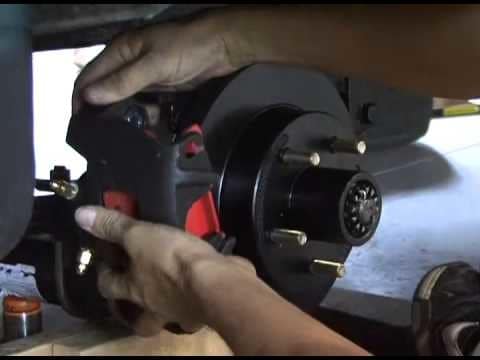
You will find two different versions of the braking system in enclosed trailers, electric drums, and hydraulic surge brakes.
Hydraulic surge brakes
This braking system is completely independent of the tow vehicle. There is an actuator in the trailer which is part of the coupler which forces hydraulic fluid into the brakes. This system does not require a controller to be installed in the tow vehicle. So, naturally, an advantage of this system is you can tow the trailer with a variety of vehicles.
The only real disadvantage of this system is you only have control of the trailer brakes by applying the brake in the tow vehicle.
Electric drum
These are the most popular and preferred breaking systems for enclosed trailers. Electric drum brake systems are cost-effective yet surprisingly reliable relative to the purchase price.
The disadvantage of an electric drum brake system is the yare susceptible to failure in extreme braking conditions. This is oddly similar to a camper going through Colorado with steep inclines and high altitude if you know what the author means… In all seriousness, this braking system also requires a controller to be installed in your tow vehicle. The controller is needed to send a signal from the brake pedal which then engages the braking system on the enclosed trailer.
Disc brakes
The good news to a rather uninspiring brake system discussion is that disc brakes are available with either system. Disc brakes are more expensive but worth every penny as they offer exceptional braking power. Brakes are such an important piece of driving or towing so get them.
Steel vs Aluminum Frames?
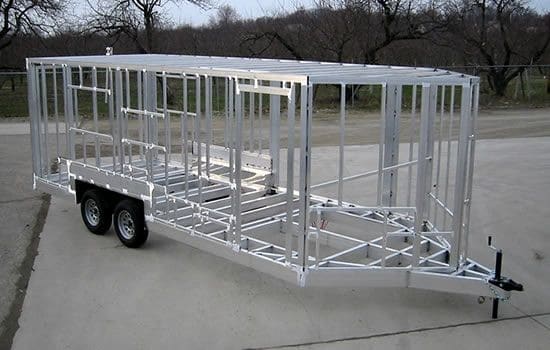
When buying an enclosed trailer for a precious restomod, you can choose primarily from steel or aluminum.
Steel frames
A steel frame is undeniably stronger than an aluminum frame. And, a steel frame, when properly coated, can absolutely last as long as an aluminum trailer. Unfortunately, many manufacturers cut corners and don’t properly coat the frame. So, they offer it as an option and the buyer declines to try to save money but doesn’t realize the importance of this decision.
The major disadvantage of a steel frame is the weight. Buyers need to make certain their vehicles can safely tow it. And, of course, the cost of fuel is expected to be greater with a heavier trailer.
Keep in mind though, that while an aluminum frame enclosed trailer is definitely lighter than steel, it’s not always as obvious as it may seem. When you’re comparing a steel and aluminum frame enclosed trailer, it has everything to do with the specific trailers you’re talking about and who manufactured them So, keep that in mind.
Aluminum frames
In my experience, almost every classic car restomod owner I met will tell you to buy an aluminum enclosed trailer. There is a popular trend to prefer aircraft-grade aluminum as it provides the best protection against cracking.
In addition to being lightweight, aluminum is almost entirely non-corrosive so the trailer will stay looking like new longer. The resale value is better as the result of depreciating less slowly than a steel frame trailer. And, of course, the popularity of an aluminum frames also makes them more preferable in the classifieds.
Aluminum vs. Composite Enclosures
The base model of nearly all enclosed trailers will be an interior skeleton with aluminum skin secured to the exterior. This will probably be what you’ll find in buying a used enclosed trailer. There is a new trend of using a lightweight single-piece composite construction.
Aluminum Enclosure
Ask a die-hard restomodder what they think about an aluminum enclosure and you’ll probably hear these cons about this:
- Aesthetics. From a functional perspective, they are fine. However, if you like to make a splash at a show pulling up in this trailer presents a few challenges. One, the wavy panels have visible seams, joint,s and/or rivets, down each side of the exterior.
- Thin-Skinned. The aluminum traps the heat or the cold inside the trailer. Essentially, the aluminum skin provides a very thin-skinned layer of protection from the elements.
Composite enclosure
A composite enclosure looks way better than an aluminum enclosure so that’s one of the first differences you’ll notice. The reason is that the composite enclosure is one entire piece which means there are no seams and rivets/joints. The exterior is reminiscent of a fancy motorcoach’s exterior.
A few other advantages of the composite enclosure is that the insulation is significantly better. So, it does protect the restomod from extreme high and low temperatures. The interior is of course also finished off very nicely and matches the exterior which is more of a high-end look and feel.
Aluminum vs composite enclosure takeaways
I guess it comes down to how much do you use your trailer. I live in Michigan and only use my enclosed travel trailer for about three months out of the year. My restomod will never see cold weather and I don’t particularly care what it looks like pulling up to a car show. I prefer to drive my vehicle anyway.
Think about how much you drive the enclosed trailer and how you feel about pulling into a show with one. Be honest with yourself. Saying you don’t care about how it looks and then caring how it looks, is a problem. And you will probably be buying a different trailer within a year.
Would I buy an enclosed trailer with each an aluminum or composite construction? Hmmm, I’d much rather spend the extra money on my restomod. I would ultimately go with what I thought the best deal was. Buying right, and paying a little bit more is fine. However, I don’t see a ton of value in paying extra for a composite from a functionality perspective, in my scenario. Yours may be entirely different and that’s fine.
What About The Tie-Down System?
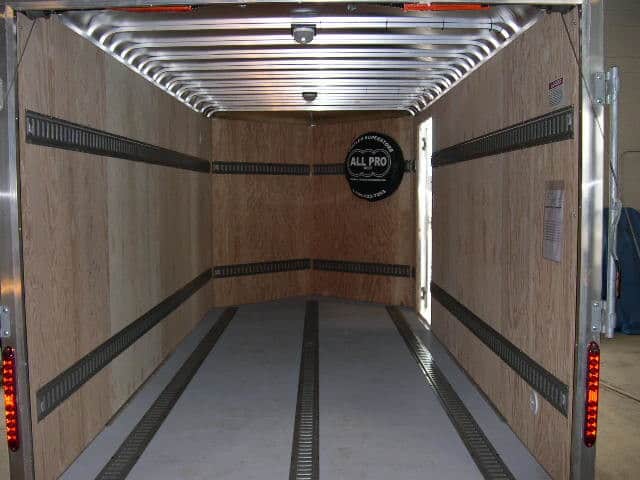
Tieing down your restomod can be difficult but it’s not the horror story you’ve heard of if you read this section. And, in my opinion, it’s not as difficult as getting in and out of your car (unless you have a left/middle door). However, if not done right, it’s a not-too-distant second from getting in and out of the car and requires a lot of patience and practice. This is especially true with a used enclosed trailer.
D-RING
The most common and/or traditional way to tie down a restomod is with what’s called a D-Ring. A D-Ring is typically placed in each corner of the trailer and is completely affected by the size of your restomod. You will feel like you’re strapping down an elephant as you’ll need very long straps.
Versatrack
A newer more advanced way of tieing down restomods is to leverage a versatrack system, commonly called a V-track. This track system has been specifically designed for cars and is installed on the trailer floor. So, you can move the tie-down rings to any place on the rack you choose – making the process incredibly more simple and more secure.
Customized
The best way to transport a restomod, and what I HIGHLY recommend, is to just spend the money to have the generic track installed customized for your specific vehicle. By doing so, you will have the tracks in front of each tire so you can place a strap over each one. There are two primary benefits of this approach as follows:
- Frameless Tie Down. You can hold the car in place in a very professional high-quality manner without securing any tie-downs around the frame.
- Avoid Scratches. Let’s face it, you probably did a frame-off restoration for a reason. So, this approach allows you to avoid scratching the frame, entirely.
- Low Cost/Big Benefit. You can usually get this done for free if you’re buying new and they haven’t installed the versatrack yet. If you’re buying used, this is a simple project for a professional operation.
As you can tell, there is a very obvious way to do tie-downs when using your enclosed trailer to transport a specific restomod. Demystify the entire process and give yourself, and the vehicle, the best option and get it customized to your vehicle. It costs hardly anything and is a real no-brainer.
Complete Guide to Buying An Enclosed Trailer for Your Restomod – Wheels & Tires
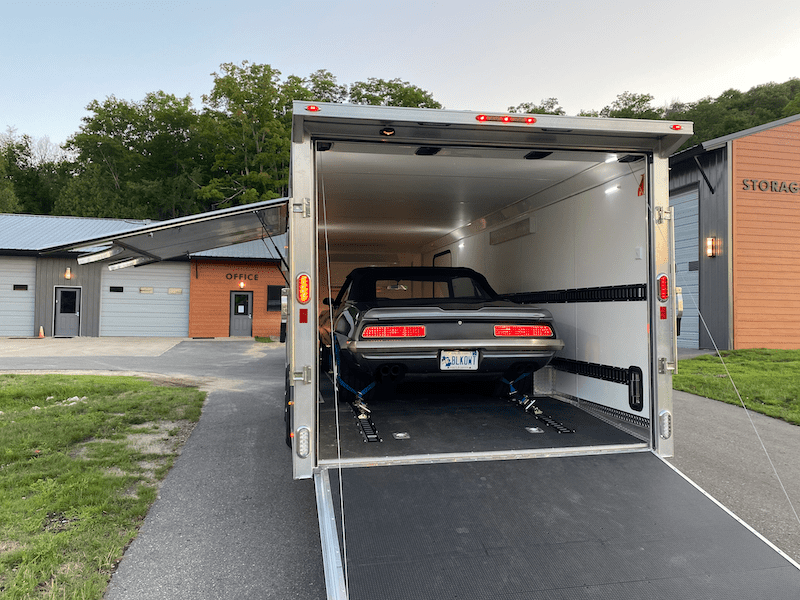
The wheels and tires of an enclosed trailer play a very important role in vehicle safety and ride comfort. For the most part, most new enclosed trailers will use solid wheels and tires. There are always a few bad apples where the dealers cut corners, as we discussed above given the low entry-level price of new trailers.
However, by and large, the following things to look for in this area are extremely applicable to used enclosed trailers:
- Load Rating. The tires need to be rated for the gross vehicle weight rating.
- ST Designation. The ST designation is a sign the tires are designed for trailer use. Do not accept a new vehicle with lesser-rated tires. If buying a used vehicle, all bets are off but you’ll at least know how to negotiate/budget for this item.
- Wheels. Most wheels are painted steel variety. However, there is a tremendous difference in the quality of wheels and tires for that matter.
- Radial vs Plys Tires. Radial tires, by far, and much better than plys tires. Radial tires provide a better ride, improved durability, and last a lot longer. If you buy an enclosed trailer with plys tires, just know the more plys the more mileage you’ll get out of them.
Getting Your Vehicle In & Out
One of the biggest challenges with a trailer is getting your vehicle in and out of it 0 especially if you have to deal with ramps. Admittedly, most new enclosed trailers have the rear door double as a ramp. Unlike an open trailer, this makes getting your vehicle in and out of the trailer simple. However, it’s not a silver bullet.
First of all, there are still some new enclosed trailers that use ramps. And, for many cars that’s fine. However, if your car is low that may be a big problem. If you own a low restomod, make sure the trailer has a dovetail. This is a nice feature and what it does is the back several feet of the trailer have a gradual slope. The slope ensures your car doesn’t high center upon entering the trailer.
The loading height is an interesting measurement and useful primarily with a low vehicle. Basically, loading height is the height at the rear of the door trailer from the ground to the top of the floor. It’s possible to mess around with jacks on the trailer to make it all work if you fall in love with a trailer I suppose. However, there are certainly trailers that work better with lower restomods than others and some basic research will provide many answers.
Tip: A left door, oftentimes called a middle door, is a very handy feature. It makes getting in and out of the car so much easier.
Financing Your Enclosed Trailer
Interest rates are at an all-time low so many people are considering buying and financing an enclosed trailer. Financing an enclosed trailer is an extremely fast process and the process looks something like this:
- Fill out an online application
- Select the financing terms that best meet your needs
- Documents are sent via email for eSignature via a phone or a computer
- You have an instant decision
If you have good credit you can usually get nearly an instant approval or within about 30 minutes. Those with poor credit, or recently improved but previously poor credit, may see their decision time take as long as 48 hours.
There are a plethora of financing companies and you should check with your local bank. Most dealers have zero down financing with term lengths varying from 3 to 5 years. I have heard of bank lending on a trailer for as long as 15 years though. Just like with getting financing for a restomod, it pays to shop around.
Maintenance On An Enclosed Trailer
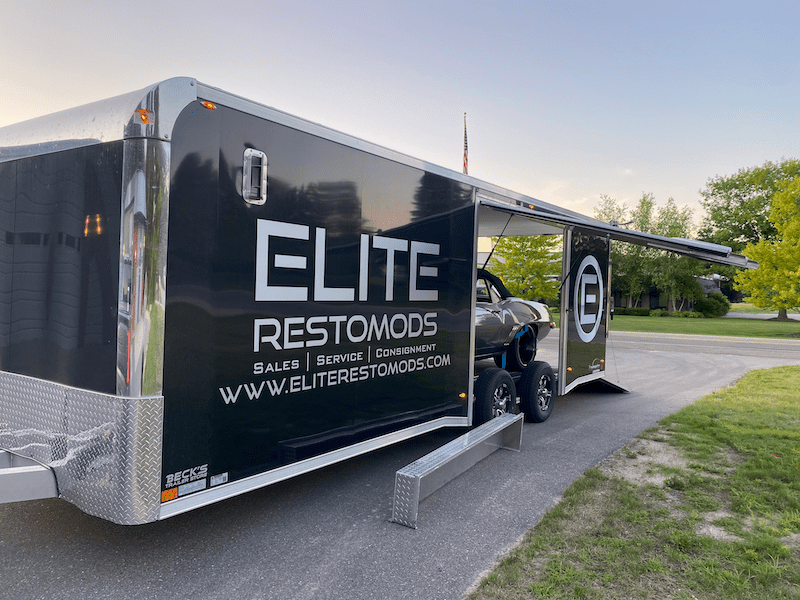
Just like a car or camper, an enclosed trailer has certain regular maintenance issues to address. Here is a simple list of them to keep in mind:
- Check the tire pressure and make sure they are between 30-40 pounds per square inch (psi)
- Check the lighting both inside the trailer as well as the turn signals.
- Ensure the bearing is properly lubricated every 12,000 miles or at least once annually.
- Check to ensure the lug nuts are tightened properly at least twice every 1,000 miles.
- check the condition of the safety chains to make sure the trailer and your restomod are safe.
- Review the overall condition of the trailer by walking around and looking underneath it. This is important as trailers are lightweight and do experience wear and tear.
Related Questions
The side of the enclosed car trailer you need depends on the towing capacity of your vehicle, the weight of your trailer, the weight of the vehicle residing in your trailer, and any equipment and supplies you plan to carry in the trailer.
If the trailer is a “V” nose, the length normally is not included in this measurement. Many “V’ nose trailers add an additional 2 feet to the length of the trailer. In summary, a 24-foot “V” nose trailer maybe a total of 26 feet, measured from the farthest point in the front to the back of the trailer.
GVWR stands for Gross Vehicle Weight Rating, and it’s a number that represents the maximum value of what your vehicle can safely weigh including payload. To give you an example, your truck may have an ’empty’ weight of 5,500 pounds (often called a “curb weight”) and a GVWR of 7,000 pounds.
The federal requirement specifies that, when a vehicle has a gross vehicle weight range (GVWR) of 26,000 pounds or less, the operator does not need a CDL license. However, this does not mean the truck GVW can be loaded above the GVWR of 26,000 pounds and operated by a non-CDL driver.
